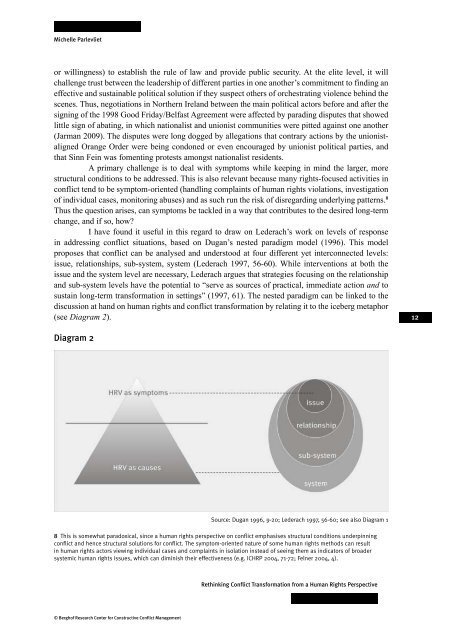Rethinking Conflict Transformation from a Human Rights Perspective
Rethinking Conflict Transformation from a Human Rights Perspective
Rethinking Conflict Transformation from a Human Rights Perspective
You also want an ePaper? Increase the reach of your titles
YUMPU automatically turns print PDFs into web optimized ePapers that Google loves.
Michelle Parlevliet<br />
or willingness) to establish the rule of law and provide public security. At the elite level, it will<br />
challenge trust between the leadership of different parties in one another’s commitment to finding an<br />
effective and sustainable political solution if they suspect others of orchestrating violence behind the<br />
scenes. Thus, negotiations in Northern Ireland between the main political actors before and after the<br />
signing of the 1998 Good Friday/Belfast Agreement were affected by parading disputes that showed<br />
little sign of abating, in which nationalist and unionist communities were pitted against one another<br />
(Jarman 2009). The disputes were long dogged by allegations that contrary actions by the unionistaligned<br />
Orange Order were being condoned or even encouraged by unionist political parties, and<br />
that Sinn Fein was fomenting protests amongst nationalist residents.<br />
A primary challenge is to deal with symptoms while keeping in mind the larger, more<br />
structural conditions to be addressed. This is also relevant because many rights-focused activities in<br />
conflict tend to be symptom-oriented (handling complaints of human rights violations, investigation<br />
of individual cases, monitoring abuses) and as such run the risk of disregarding underlying patterns. 8<br />
Thus the question arises, can symptoms be tackled in a way that contributes to the desired long-term<br />
change, and if so, how?<br />
I have found it useful in this regard to draw on Lederach’s work on levels of response<br />
in addressing conflict situations, based on Dugan’s nested paradigm model (1996). This model<br />
proposes that conflict can be analysed and understood at four different yet interconnected levels:<br />
issue, relationships, sub-system, system (Lederach 1997, 56-60). While interventions at both the<br />
issue and the system level are necessary, Lederach argues that strategies focusing on the relationship<br />
and sub-system levels have the potential to “serve as sources of practical, immediate action and to<br />
sustain long-term transformation in settings” (1997, 61). The nested paradigm can be linked to the<br />
discussion at hand on human rights and conflict transformation by relating it to the iceberg metaphor<br />
(see Diagram 2).<br />
Diagram 2<br />
© Berghof Research Center for Constructive <strong>Conflict</strong> Management<br />
Source: Dugan 1996, 9-20; Lederach 1997, 56-60; see also Diagram 1<br />
8 This is somewhat paradoxical, since a human rights perspective on conflict emphasises structural conditions underpinning<br />
conflict and hence structural solutions for conflict. The symptom-oriented nature of some human rights methods can result<br />
in human rights actors viewing individual cases and complaints in isolation instead of seeing them as indicators of broader<br />
systemic human rights issues, which can diminish their effectiveness (e.g. ICHRP 2004, 71-72; Felner 2004, 4).<br />
<strong>Rethinking</strong> <strong>Conflict</strong> <strong>Transformation</strong> <strong>from</strong> a <strong>Human</strong> <strong>Rights</strong> <strong>Perspective</strong><br />
12
















